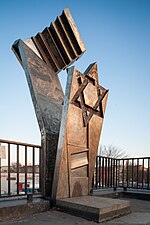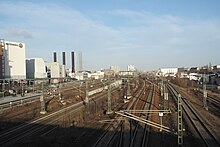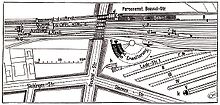Berlin-Moabit train station
| Berlin-Moabit | |
|---|---|
|
View of the train station from the Beusselbrücke
|
|
| Data | |
| Location in the network | Crossing station |
| Design | Through station |
| Platform tracks | 0 |
| abbreviation | BMOA |
| opening | 1871 |
| location | |
| City / municipality | Berlin |
| Place / district | Moabit |
| country | Berlin |
| Country | Germany |
| Coordinates | 52 ° 32 '4 " N , 13 ° 20' 9" E |
| Railway lines | |
| Railway stations in Berlin | |
The Berlin-Moabit station in the Berlin district of the same name is a station at the junction of the Berlin Ringbahn with the Hamburger and Lehrter Bahn . It was used for passenger traffic until 1894, and since then it has been an important freight station . In the meantime, it has largely lost this function, too; today the station still fulfills operational tasks. A combined signal box and water tower building erected by Karl Cornelius in 1892/93 in the western part of the station is a listed building .
location
The station is in the north of Moabit, south of the western port . The Ringbahn runs in this area approximately in a west-east direction. Your S-Bahn tracks, which do not belong to Moabit station, form the northern border of the station, Siemensstrasse and Quitzowstrasse are south of the station. The west end of the station is to the west of the Beusselstraße S-Bahn station , to the east the station extends beyond the Westhafen S-Bahn station . In Moabit train station, the kilometering of the ring line begins (km 0.0). The route of the Hamburger and Lehrter Bahn runs in the east of the Moabit train station in a south-east direction from the Ringbahn, in a westward direction to the Jungfernheide area the routes run parallel. One track of the old railway line to the Lehrter Bahnhof is still used today for freight traffic to the Hamburg and Lehrter freight stations , and the new north-south long-distance line towards Berlin Hauptbahnhof has been in operation since 2006 .
history
The beginnings
On July 17, 1871, the first part of the then New Berlin Connection Railway, called the Berlin Ring Railway, went from Moabit to the east, initially for freight traffic. From the beginning it was linked to the freight track of the Lehrter Bahn, then also to the Hamburger Bahn. On January 1, 1872, passenger traffic began on the Ringbahn and Moabit became a passenger station. In 1877 the Ringbahn also went into operation from Moabit to the west and the ring was closed. After the Berlin-Hamburg Railway had set up so-called omnibus trains for suburban traffic between Berlin and Spandau in 1880 , they were given a Plötzensee stop from May 5, 1881 , about 300 meters east of the Beussel Bridge, so that there was a transfer to Moabit station on the Ringbahn. The omnibus trains and the Plötzensee stop only existed for a short time, as from June 1, 1882, the suburban traffic of the Hamburg Railway was switched to the city railway .
As the last of the large private railways in Prussia, the Berlin-Hamburg Railway was nationalized in a contract signed in 1884, the nationalization came into effect on January 1, 1886, and all lines in contact with Moabit station were part of the Prussian State Railways . In the following years, the operation of the Hamburg and Lehrter Bahn in Berlin was gradually merged. The growth of the city and the increase in industry led to a significantly increased volume of rail traffic, so that extensive expansion of the railway network was necessary. Among other things, the ring line had to be expanded to four tracks and thus receive separate systems for suburban traffic.
The Moabit train station proved to be an operational bottleneck. In a draft of a railway loan law in April 1889 it was determined that 132 scheduled trains in both directions, sometimes up to ten in one hour, had to be dispatched at Moabit station. The common management of passenger and freight traffic on the same tracks turned out to be a problem. This had the consequence that with an expansion of the traffic on the Ringbahn by only one train per hour and direction on the route
“And especially in the Moabit station the existing evils become even more pronounced; yes, it is to be feared that the delays and irregularities in train traffic caused by this will also be carried over to the subsequent four-track line. "
Due to the location of the station, a mere expansion of its facilities was not sufficient; it was necessary to separate passenger and freight traffic. As a result, Moabit railway station lost its passenger transport duties.
“The current passenger station Moabit, which is not conveniently located for traffic, can then be replaced by a station at the Beusselstrasse overpass and, as soon as the Stromstrasse overpass planned by the city of Berlin has been carried out, a second station to the latter. "
Moabit as a freight yard
With the separation of passenger and freight traffic, the routes in the Moabit area could be better linked and the local freight facilities expanded. During the renovation, a fourth pair of tracks was built south of the three existing pairs. The two newly built tracks were the freight tracks of the Ringbahn and the former tracks of the Ringbahn and Lehrter Bahn were used by Lehrter and Hamburger Bahn. The former tracks of the Hamburger Bahn have been used for passenger traffic on the Ringbahn ever since. On May 1, 1894, Moabit station was closed to passenger traffic and replaced by a new stop on Beusselstrasse west of the station. The stop in Jungfernheide went into operation on the same day .
The long-planned passenger stop for the Ringbahn on Stromstraße was opened on October 1, 1898, but the overpass was not built until 1912. The stop was named Putlitzstraße (today: Westhafen ). There was not only a platform on the suburban tracks of the Ringbahn, but also on the Lehrter Bahn slightly to the west, so that there was a possibility to change trains. The platform on the Lehrter Bahn was also named Putlitzstraße, although it was already in the area of the Moabit train station.
The main purpose of the station was to link up with the freight yards of the Hamburg and Lehrter Bahn (e.g. the Lehrter Bahn customs station on the Moabiter Werder , later called Spreeufer station, or the Hamburg and Lehrter freight yards on Heidestrasse). It was initially also a transfer point to and from the Hamburg and Lehrter Bahn until the railway companies were nationalized. Accordingly, it was a main task of the station to form and disband trains to and from the various railways . The local volume consisted, among other things, of general cargo traffic, the servicing of small businesses in the station area and the link with various connecting railways.

In 1914, work began on the Westhafen north of the station, which was expanded until 1927 and received a rail connection. Since the suburban tracks of the Ringbahn are between Moabit station and the Westhafen, the Westhafen could not be connected directly to Moabit station. The trains had to go via the Hamburger and Lehrter freight depots, where a change of direction was necessary.
Deportation place of the Jews from Berlin, today a memorial place
From probably January 1942 the station was used for the deportation of Berlin Jews . Around 30,000 Berliners were deported from the ramps of the freight station to various concentration camps. From 1942 to 1945 they were deported to the extermination camps from tracks 69, 81 and 82 in the train station east of the Putlitz Bridge. From the synagogue in Levetzowstrasse , which had been converted into a collection point , they were driven onto the trains via Quitzowstrasse. From the eastern part of Quitzowstrasse, a cul-de-sac, later known as the deportation route , leads to the ramps on the tracks. There is a plaque commemorating the deportation. In 2017, a memorial site was designed on the cul-de-sac, consisting of 20 pine trees, a 15-meter-long remnant of the former track 69 and a sheet pile wall as part of the earlier ramp. The project cost 200,000 euros. The cul-de-sac and ramp with the remains of track are listed as "deportation facilities at the former Moabit freight yard". In addition, the Putlitzbrücke deportation memorial designed by Volkmar Haase is located on the Putlitzbrücke .
- See also: at today 's Grunewald S-Bahn station , there the Gleis 17 memorial (1998)
After the Second World War
After the Second World War and the division of Germany and Berlin , traffic in this area fell significantly. Lehrter Bahnhof was in operation for passenger traffic until 1951, as was the Putlitzstraße suburban platform in Moabit station. A few years after the cessation of passenger traffic, the platform was cleared. The long-distance tracks in the Moabit area were still used for local freight traffic as well as freight trains in the direction of Hamburger and Lehrter station, Spreeufer, Westhafen and the north-eastern part of West Berlin . In the course of the years, the freight traffic decreased more and more, the tendency continued after the German reunification in 1990. In 2005 the freight yard was closed. The systems in the northern part of the station that are required for train formation and other operational tasks remained. The Westhafen and the Moabit power station are connected from the Moabit train station via the Hamburg and Lehrter freight stations.
After 2000, the railway facilities in Berlin were redesigned. Was rebuilt u. a. the north-south long-distance railway and the Berlin central station . The new route of the Lehrter Bahn from the main train station also crosses the ring line at Moabit station; the station systems were electrified. What remains is a non-electrified connection route to the Hamburg and Lehrter freight depots.
Most of the Moabit freight yard has now been dismantled. The Park Stadtgarten Moabit was built on a 9000 square meter area from 2007 to 2012. In 2009, Ellen-Epstein-Straße was expanded in the eastern section of the station. Ellen Epstein was a Jewish musician who was deported from the freight yard to Riga in 1942 and killed there. Erna-Samuel-Straße was completed in its western extension at the end of 2013. Erna Samuel was a Jewish teacher who was murdered in Auschwitz concentration camp in 1942 after her deportation from Moabit train station .
Investments
Track systems
The existing facilities at Moabit station are located south of the S-Bahn tracks of the Ringbahn and essentially consist of more than ten parallel tracks. To the east of the Putlitz Bridge, the Ringbahn and the lines to the main train station and to the Hamburg and Lehrter freight depots separate in a crossing structure. The Lehrter Bahn and the Ringbahn separate to the west of Beusselstrasse. South of these tracks was the former freight yard with a series of parallel loading lanes diagonally to the main tracks, which were approached from the east. Its track systems are dismantled.
Other plants

In the triangle between the main tracks, the freight tracks and Beusselstrasse, the locomotive treatment systems with locomotive sheds and turntables were no longer preserved . There is also the listed Mwt signal box ( Moabit West, tower signal box), which served as both a signal box and a water tower. It was built by Karl Cornelius during the major renovation of the station in 1892/93 . It consists of a three-storey substructure with yellow brick cladding and the half-timbered floor above for the water supply to the locomotives. The adjoining engine shed was destroyed in the Second World War. On the east side of the building is a small extension that Karl Cornelius built in 1913 for the lamp cleaners and shunters.
Most of the other structures at the station no longer exist. A goods shed in the part of the station on Siemensstrasse used as the Park Stadtgarten Moabit was preserved. It has been renovated and is used by the Center for Art and Urbanism (ZK / U) of the KUNSTrePUBLIK association. Furthermore, a community garden with beds and a meadow with fruit trees were created in the city garden. Curved rails with two swings and a giant hammock serve as a reminder of the station.
To the south of the tracks in the area of the loading streets, a number of smaller businesses settled on Quitzowstrasse and Siemensstrasse. This structure has been partially preserved, especially in the Quitzowstrasse area.
literature
- Alfred Gottwaldt: Dunning place Moabit freight station. The deportation of Jews from Berlin . Hentrich & Hentrich Verlag Berlin, Berlin 2015, ISBN 978-3-9556505-4-4
Web links
Individual evidence
- ^ Peter Bley: 150 Years of the Berlin – Hamburg Railway. On the route of technical progress alba, Düsseldorf 1996, ISBN 3-87094-229-0 , p. 67.
- ^ Peter Bley: 150 Years of the Berlin – Hamburg Railway. On the route of technical progress alba, Düsseldorf 1996, ISBN 3-87094-229-0 , p. 77.
- ^ Peter Bley: 150 Years of the Berlin – Hamburg Railway. On the route of technical progress alba, Düsseldorf 1996, ISBN 3-87094-229-0 , p. 78.
- ^ Peter Bley: 150 Years of the Berlin – Hamburg Railway. On the route of technical progress alba, Düsseldorf 1996, ISBN 3-87094-229-0 , p. 79.
- ↑ a b c Bernd Kuhlmann: The Berlin train stations. Bruckmann, Munich 2010, ISBN 978-3-7654-7086-8 , p. 88.
- ↑ a b c Güterbahnhof Moabit on siewarennachbarn.de, accessed on February 16, 2013
- ↑ 24 pines are supposed to remind of deportations. In: Der Tagesspiegel . April 20, 2017. Retrieved April 21, 2017 .
- ↑ Entry in the Berlin State Monument List
- ↑ a b Stadtgarten Moabit on the website of the Berlin Senate Department for Urban Development and Renovation, accessed on February 16, 2013
- ↑ Clear the road for women. In: TAZ , January 11, 2010.
- ↑ Entry in the Berlin State Monument List with further information
- ^ ZK / U: Website of the Center for Art and Urbanism. KUNSTrePUBLIK, March 22, 2018, accessed on March 22, 2018 (English, German).






